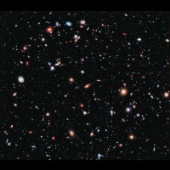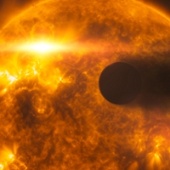ESA Science & Technology - Science Results
Science Results
Science Results
ESA's Huygens probe bounced, slid and wobbled its way to rest in the 10 seconds after touching down on Saturn's moon, Titan, in January 2005, a new analysis reveals. The findings provide novel insight into the nature of the moon's surface.
Published: 11 October 2012
ESA's Herschel space observatory has discovered enough water vapour to fill Earth's oceans more than 2000 times over, in a gas and dust cloud that is on the verge of collapsing into a new Sun-like star.
Published: 9 October 2012
Pristine material that matches comets in our own Solar System have been found in a dust belt around the young star Beta Pictoris by ESA's Herschel space observatory.
Published: 3 October 2012
Venus Express has spied a surprisingly cold region high in the planet's atmosphere that may be frigid enough for carbon dioxide to freeze out as ice or snow.
Published: 1 October 2012
Astronomers have assembled a new, improved portrait of our deepest-ever view of the Universe. Called the eXtreme Deep Field, or XDF, the photo was assembled by combining ten years of Hubble Space Telescope observations taken of a patch of sky within the original Hubble Ultra Deep Field. The XDF is a small fraction of the angular diameter of the...
Published: 25 September 2012
Despite more than a century of observations, the orbit of the Martian moon Deimos is still not known to a high degree of accuracy, but a new study using images taken by ESA's Mars Express orbiter has provided the best orbital model to date.
Published: 24 September 2012
Astronomers using XMM-Newton and Suzaku have detected the final signal sent by the debris of a disrupted star before it disappeared beyond the event horizon of a distant, supermassive black hole.
Published: 3 August 2012
Scientists have detected and characterised lower hybrid drift waves - plasma waves that develop in thin boundaries and play an important role in energy transfer between plasma layers in the magnetosphere.
Published: 1 August 2012
Scientists have probed the Sun's corona via the disturbances it causes to radio transmissions from Mars Express, Venus Express and Rosetta. This technique has allowed the detection of coronal mass ejections and revealed the morphology of these colossal solar eruptions in great detail.
Published: 24 July 2012
Astronomers have used Hubble to study some of the smallest and faintest galaxies in our cosmic neighbourhood. These galaxies are fossils of the early Universe: they have barely changed for 13 billion years.
Published: 10 July 2012
An international team of scientists has used the world's most powerful X-ray observatories - including ESA's XMM-Newton orbiter - to probe the dusty surroundings of a newborn star and discover some of its innermost secrets.
Published: 3 July 2012
Cassini-Huygens has found large tides on Saturn's moon Titan, pointing to the existence of a liquid ocean - most likely composed of water - swirling around below the surface.
Published: 28 June 2012
Astronomers using the Hubble Space Telescope have seen dramatic changes in the upper atmosphere of a faraway planet. The observations give a tantalising glimpse of the changing climates and weather on planets outside our Solar System.
Published: 28 June 2012
A new study of the ancient, cratered highlands of Mars has detected numerous exposures of minerals that were altered by underground water during the planet's early history.
Published: 27 June 2012
[05/06/2012]
Cluster observations may have solved the long-standing debate on the origin of highly energetic particles in the cusps of Earth's magnetosphere.
Cluster observations may have solved the long-standing debate on the origin of highly energetic particles in the cusps of Earth's magnetosphere.
Published: 5 June 2012
Astronomers studying the galaxy NGC 4151 have detected X-rays emitted and then reflected from the vicinity of the supermassive black hole at the galaxy's core, thus revealing the black hole's vicinity in unprecedented detail.
Published: 31 May 2012
The long and tumultuous history of asteroid (21) Lutetia is revealed by a comprehensive analysis of the data gathered by ESA's Rosetta spacecraft when it flew past this large main-belt asteroid on 10 July 2010.
Published: 29 May 2012
Herschel survey confirms that only the most powerful black holes in the early Universe were able to quench the formation of stars in their host galaxies.
Published: 10 May 2012
The first targeted, high resolution measurements of Martian gravity have enabled scientists to probe deep beneath the surface of Mars and provide new insights into the formation of the planet's massive volcanoes.
Published: 26 April 2012
A region on Saturn's moon Titan has been found to be similar to the Etosha Pan in Namibia, Africa. Both are ephemeral lakes - large, shallow depressions that sometimes fill with liquid.
Published: 19 April 2012
—
20 Items per Page




















